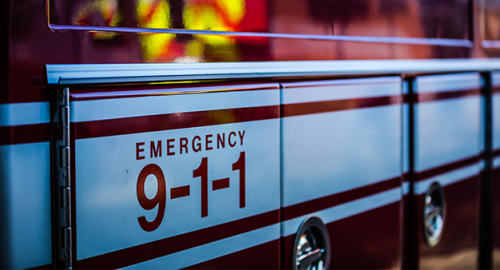In a recent webinar, K-12 experts and law enforcement leaders discussed why the partnership between law enforcement and schools is critical to school safety. The panel includes:
- James Englert: SRO at Arapahoe County Sheriffs Office and Board Member of The I Love U Guys Foundation and National Association of School Resource Officers (NASRO)
- Chris Zimmerman: Principal at Douglas County School District and Board Member of The I Love U GuysFoundation
- Carly Posey: Mission Director of The I Love U GuysFoundation
- Phil Coyne: President of Critical Response Group
- Jim Vesterman: Former CEO of Raptor Technologies
Below are highlights from the panel discussion. You can listen to the full conversation here.
Ways to Adjust School Safety Procedures & Maintain Health Precautions Brought on by the Pandemic
How has COVID-19 impacted school safety?
Chris: To bring students and staff back into the schools, we had to evaluate the different safety protocols around COVID-19 and make sure we have the right resources in place to keep everyone safe. There must be policies for things like responding to an active case, maintaining the recommended physical distancing, and choosing a learning approach. It’s important to have constant flexibility within your processes and ask for feedback to improve them. Communication with students, staff and most importantl your parents is also critical. Many parents are having to step in and help their kids with safety and learning aspects, especially with a hybrid or remote learning approach.
How has COVID-19 affected our traditional school safety protocols?
James: We cant forget about the basics of school safety. For example, some schools are not conducting full lockdown drills or are propping doors open so kids dont touch the door handle. Consider what would happen if the school went on lockdown. It is a safer school when those doors can immediately be locked at any second. COVID-19 has also changed how SROs build relationships with students. Its been difficult this year to do that, especially when students are wearing masks and only coming to school part-time.
Chris: I think it is possible to conduct drills to create muscle memory and test your processes if everyone is wearing masks and socially distancing. If we are not conducting these drills, it makes it difficult to respond in an actual emergency because teachers, staff, students, and incident commanders would have to think through how to respond because their bodies are not used to making the movements.
Phil: COVID-19 has disrupted the emergency operation plans that schools have committed a lot of time and energy into creating. To reduce traffic in the hallways, for example, some schools have exterior tents and kiosks that result in a crowd of students waiting outside. Communicating these changes with law enforcement and thinking about what an emergency response would look like in this situation is important to keeping schools safe.
Carly: Its important to have a relationship between schools, law enforcement, and community members because it helps us see school safety through different lenses. Schools can get into tunnel vision right now because its so much work to respond to COVID-19. Schools choosing to leave doors open to reduce the spread of the virus may not be considering what that does for intruders. A relationship with law enforcement and others can help schools detach from COVID-19 and think about the complete picture of school safety again.
How has COVID-19 changed visitor management and visitor activity?
Jim: The virus created a need for a few COVID-19 visitor management solutions. Raptor Visitor Management enables schools to screen students, staff, and all visitors with COVID-19-related health questions. We have an on-site option and a remote screening option that students and staff can complete before they leave for school. Raptor reporting features also allow schools to facilitate contact tracing.
Strategies for Intentional Relationship Building Between Schools & Law Enforcement
What actions can school leaders take to build relationships with their local law enforcement personnel?
Chris: Involving law enforcement and first responders in your drills is a perfect opportunity to establish a relationship and get their feedback on your processes. The relationship is critical when an actual crisis occurs, as it makes the response go smoother and safer. Schools can also include law enforcement in an educational setting, such as inviting them to speak at a health class about drugs, alcohol, or bullying. Giving law enforcement the opportunity to come to the class, teach kids, and have these conversations helps build a trusted relationship. Another critical strategy is having law enforcement, EMT, and other first responders in your building as much as possible. Offering your building as a training space when its empty, for example, lets the first responders get to know your building. This creates muscle memory, which will them help significantly during an actual crisis.
James: SROs have robust training like what I instruct with NASRO that helps the SRO recognize and respond to incidents or signs of mental health or trauma. Its also important that SROs and law enforcement have relationships with principals and school administrators to expedite response to incidents.
Phil: There are multiple layers of public safety, from municipal, state, or county, that can respond to an emergency. An SRO can help build the relationships with these different public safety groups. It’s critical for schools to also identify shared objectives with law enforcement and define a successful SRO and law enforcement program. Schools can review the program throughout the year to see if anything needs to be corrected, as opposed to correcting a process after an event occurs.
Tools First Responders & Schools Can Use to Increase Their Coordination During A School Emergency
What are the most effective ways schools and law enforcement can partner together to prepare for an emergency?
Phil: Schools must understand the true nature of an emergency response and the public safety groups that are going to respond. Schools can be hyper-focused on law enforcement, but fire and EMS are also integral components of emergency response. In an emergency, we are asking people to make a quick transition from routine activities to emergency activities. First responders are trained to do this, but it’s not the daily experience or expectation of people within the school. Everybody then must collaborate in a very stressful situation. Using tools can reduce complexity by enabling clear communication and quick access to important information.
School administrators also must ask themselves how the tool fits into their emergency response and how it is being included into the procedures of the public safety that is responding. An SRO can help facilitate that conversation. Schools should also do a risk assessment to see where their safety gaps are and what threats and mitigation strategies to put in place. Your assessment should include how you define your buildings. Its illogical to assume that every person who responds is familiar with your buildings. Planning routine walkthroughs, using clear language, and having the right terminology in your response policies helps people speak the same language during the response.
Doing a full-scale exercise is laborious, but you can have routinely smaller table-top exercises to make sure that the technologies and processes you have in place are understood. Like mentioned before, creating that muscle memory with drills is critical. People will react to the crisis based on that muscle memory.
James: I recommend at minimum table-top exercises to make sure everyone is on the same page. There are basic things that we may not think aboutlike how we refer to a classroom for example and we can think things will just come naturally during an emergency. But youre not going to be the same person right now as in an emergency. You’re going to be under stress.
Carly: It’s important to also think about after the emergency and including first responders in your reunification plan. They are an integral part of reunification, so its just as important that they know that policy as well as the emergency response procedures the school has in place.
Jim: Raptor Alert expedites emergency response and also provides communication between multiple first responder agencies, the school, and incident commanders. We partnered with CRG, who creates detailed maps that schools and other first responders view during the emergency so everyone is working from the same common operating picture. We have a reunification solution that helps reunify students with guardians faster, and we also have a solution for drills so schools can schedule and conduct drills faster.
Phil: Communications interoperability is a key takeaway of the 9-11 Commission Report. Its critical to have systems that facilitate the communication across different groups of responders. Emergency response comes in waves. Theres the initial response, a more tactical response, and then theres the more strategic response and all of these have moving parts. When you look at reunification, which is a crucial component of response, having a technology in place that weaves these components together helps create a better response.
Raptor was founded in 2002 with the mission to protect every child, every school, every day. Completely built in-house, Raptor integrated safety solutions protect over 32,000 K-12 schools, empowering them to stay focused on their highest calling: cultivating educated, civic-minded students. To learn more about Raptor, contact us today to set up a personalized demo.





